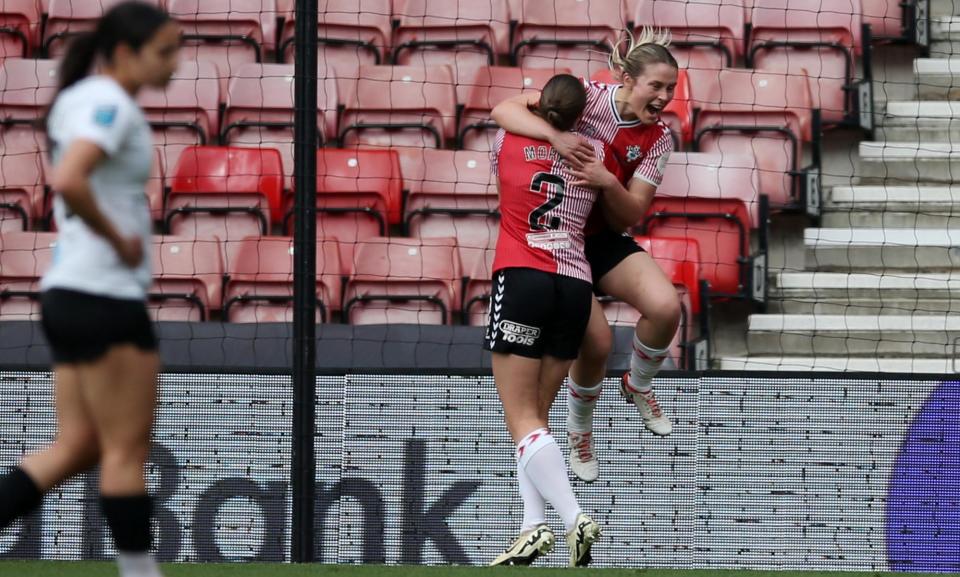Women’s football in England enters NewCo era amid promise and risk

“It’s like a start-up tech company in Silicon Valley,” says Baroness Sue Campbell, recalling Michele Kang’s description of NewCo, the independent company that will take over running the Women’s Super League and Championship from next season.
It is the start-up that drew Kang, one of the most recognisable businesswomen in women’s football, with a portfolio including ownership of Washington Spirit and a majority share in Lyon, to acquire London City Lionesses, who sit mid-table in the second tier of English football. That is the same independent club whose players, at the end of last season, warned the previous owner, Diane Culligan, the “very existence” of the side would be under threat without more investment.
Related: Wor Bella: forgotten story of women who combined war work with football
The Women’s Championship showcases the wider picture of women’s football in England: the post-Euros boom and the challenge to sustain it, professionalisation, increased competitiveness, and the potential for commercial growth and all the threats that poses. NewCo’s creation was overseen after the Euros in 2022 by Campbell, who is retiring from her role as the Football Association’s director of women’s football this year. She talks of having a “missionary zeal” to grow the game.
“I have this famous expression that everyone repeats back to me,” Campbell says. “It’s” ‘I don’t want the head to leave the body.’ To me, one of the greatest strengths of the English game is the pyramid. If you cut that off, you cut off the dream. We’ve done a lot at the top and at grassroots, but the ladder in between is a bit squeaky. Some of the rungs are missing.”
The Championship title race is as thrilling as they come: four points separate the top four sides. “The league is more competitive than it has ever been,” says Marieanne Spacey-Cale, the manager of Southampton, who are third. “The table doesn’t lie.”
It is also the highest level at which you find clubs without an association with a large professional men’s side. And if the table doesn’t lie, it hints at a divide forming. London City Lionesses, Durham, and Lewes – the three Championship clubs unaffiliated to a big men’s club – will finish in the lower half. Relegation remains a possibility, for second-bottom Lewes in particular.
“The challenge with the Championship is that the level of investment required is starting to grow,” Campbell says. “Kang is a classic example of taking on a club finding its own way with no parent body. I don’t think without [that] those independent clubs will survive.”
Lewes’s fan engagement officer, Shreyans Nilvarna, says: “Put simply, if big clubs in the Championship suddenly decide to invest £5m more to build a team, it puts clubs like us out of the competition. We don’t have a massive men’s club which can put money in to keep us going. It is a constant challenge to raise those funds.”
At Lewes, who have a fan ownership model and rely on bespoke brand partnerships, an existential threat is never far away, compounded by their relegation fight this season.
“The whole landscape of women’s football has grown quite well,” Nilvarna says. “But the Championship has struggled this season. After the Euros, the whole league had about six or seven games with attendances of 2,000 and above. This year it has only been one or two games. I hope NewCo takes the leagues together. Not just the Championship being tagged along as a little sister because the bigger sister is going somewhere.”
The women’s game continues to figure out its audience, and Campbell says that has to be “thought out in a new way … It’s not a tribal, historical connection to a club, it’s a new thing.” It is one clubs such as Lewes perhaps have some head start on.
“We use it to our advantage in building a fanbase just for the women’s team,” Nilvarna says, “We think there’s a massive audience which other clubs in the league might miss.”
There are other advantages to more independent setups. Kang said acquiring London City had been easier without having to deal as well with a men’s team setup.
“We don’t have to get things signed off,” Nilvarna says. “It’s just us and what we want to do. It gives us a lot of creative freedom.”
The looming new broadcast deal for both leagues for next season will be NewCo’s first large demonstration of how it disperses funds. It will begin a new commercial era for women’s football, where the learning curves could be catastrophic for some.
The Championship is full of teams with growth opportunities enticing to investors but it also has England’s best independently run clubs, whose vulnerabilities will be tested in the next few years.
“There might be some casualties,” Campbell says, “but that’s going to be the reality.”

